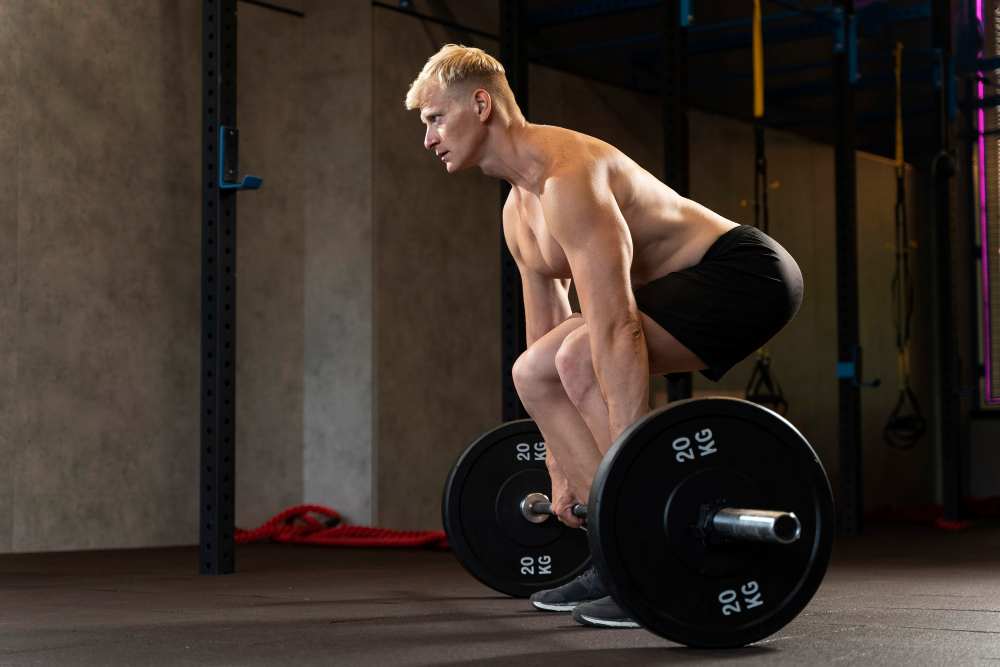If you’ve just started training at an MMA gym, chances are the bug’s already bitten you. A little friendly competition, steady progress, and suddenly you’re thinking, “Maybe I’ll test myself in the cage one day.” Totally normal. You want to be stronger, faster, harder to break.
So you hit the weights.
But weight lifting for MMA isn’t your regular gym routine. You don’t have to hit every mirror muscle or chase the pump. Instead, you should be looking to build real-world strength that holds up when you’re tired, tangled, and trying to keep your head off the mat.
However, there is always a catch. You’re already spending hours training. You know what it feels like to be wrecked after hard sparring or five rounds of pad work. So the last thing you want is to lift in a way that burns you out or slows you down.
That’s why you need a different approach. And here, we’ll break down what actually works.
Do MMA Fighters Lift Weights?
Yes. Almost every serious MMA fighter lifts weights. But they’re not doing it to look jacked for Instagram. When it comes to weight lifting for MMA, it’s all about performance.
Pro fighters lift with a purpose. If they’re moving up a weight class, they’ll often focus on building lean mass to fill out their frame and handle bigger opponents. If they’re facing a power wrestler or someone who grinds in the clinch, they might shift toward building max strength, even if it means sacrificing a bit of speed. It’s all calculated.
Now, if you’re a recreational or just starting out, you might wonder if all this applies to you. You’re not preparing for the professional organisation, but maybe you’re eyeing an amateur competition down the road. Or maybe you just want to finally tap that one friend who always gets the upper hand.
Well, it’s the same for you. Lifting the right way will make you feel sharper, more confident, and harder to deal with on the mats or in sparring.
It gives your body structure. It helps you absorb shots, break grips, and push the pace without gassing out.
Should You Work Out as an MMA Fighter?
If you’re training MMA, yes, you should absolutely lift weights.
Strength matters. It helps you scramble better, strike harder, and recover faster between rounds. But don’t just copy whatever program some popular fighter posts online.
That dude’s training is built around his body, his fight schedule, and his team of coaches and physios. Copying his exact workout when you’re juggling work, class, and three MMA sessions a week? Not going to work. You’ll burn out, stall progress, or get hurt.
Now, if you’re not training MMA, there’s no real reason to lift like a fighter. Sure, the shredded, athletic look is appealing. But fighters train the way they do because they fight, not because it’s the most efficient way to get abs.
If your goal is aesthetics or general strength, you’ll get way better results from a traditional lifting program focused on progressive overload and recovery.
How Should MMA Strength Training Look?
MMA strength training should be built around these:
- Explosive Power: For takedowns, punches, and scrambles
- Core Stability: Because everything in MMA starts from your center
- Posterior Chain Strength: Glutes, hamstrings, back.
- Mobility and Control Under Load: Awkward positions, weird angles, and pressure are the name of the game
- Efficiency: You’re already training a lot, so your lifts need to be high impact, not high volume
Best MMA Strength Exercises
These are staples and must-do MMA strength exercises:
- Trap Bar Deadlifts: Builds hip drive and grip without wrecking your lower back
- Bulgarian Split Squats: Single-leg strength for better balance and base
- Pull-Ups or Weighted Pull-Ups: Essential for clinch, grip fighting, and upper back
- Barbell Hip Thrusts: Boosts explosive hips for sprawls, takedowns, and bridges
- Landmine Presses: Great for shoulder stability and punching mechanics
- Farmer Carries: Core, grip, posture. Simple and brutally effective
- Med Ball Slams/Throws: Train power without beating up your joints
- Kettlebell Swings: Posterior chain, grip, and conditioning in one
MMA Lifting Routine
You don’t need five lifting sessions a week. In fact, 2 or 3-day MMA weight training is all you need.
Example of 2-3 day MMA Weight Training
- Day 1: Strength Focus
- Trap bar deadlifts
- Bulgarian split squats
- Pull-ups
- Farmer carries
Day 2: Power + Stability
- Med ball slams or kettlebell swings
- Landmine presses
- Hip thrusts
- Core finisher (planks, ab rollouts, etc.)
Optional Day 3: Full-Body + Conditioning
- Keep it lighter and more dynamic
- Focus on movement, speed, and recovery
Is this MMA Lifting Routine Good?
Absolutely. This is a solid starting point.
It’s balanced, efficient, and built to fit around your fight training. But keep in mind that no routine is perfect for everyone.
It’s best to treat this like a framework.
Pay attention to your body. If you’re constantly drained, sluggish in sparring, or struggling to recover, that’s a sign to scale it back. Maybe drop the third day. Or maybe trim down the sets.
And if something doesn’t feel right, swap it out. For example, if you have tight hips, weird knee pain, or discomfort with a certain lift. There’s always a suitable alternative. The best routine is the one you can do consistently without hurting yourself.
Also, don’t ignore weak spots. Got a nagging lower back? Spend more time on glute strength and core stability. Weak posture in scrambles? Add more upper back work. Your lifting should reflect the gaps in your game.
Best Bodyweight Exercises for MMA
Bodyweight exercises for MMA can also be effective if you don’t have time to go to the gym. These types of exercises can also build control, endurance, and functional strength.
Here are the best bodyweight exercises for MMA:
Push-Ups (and variations)
Builds chest, triceps, and shoulder endurance. Mix in explosive push-ups or archer push-ups to up the difficulty.
Pull-Ups or Chin-Ups
If you’ve got a bar, these are gold. You’re working your grip, lats, and upper back. This is a perfect exercise for clinch work and posture control.
Bodyweight Squats / Jump Squats
Train leg endurance and explosive power for takedowns and scrambles. Tempo squats (slow down, fast up) also fire up your control.
Lunges / Split Squats
Great for single-leg strength, balance, and fixing left-to-right imbalances.
Planks / Side Planks / Ab Rollouts
Core is everything. These help you stay strong under pressure and resist being folded like a lawn chair.
Bear Crawls / Crab Walks / Shooters
These look weird, but they train mobility, coordination, and cardio all at once. Plus, they mimic the kind of awkward movements you deal with in a fight.
Burpees
Love them or hate them, burpees build grit, explosiveness, and a gas tank. Perfect finisher when you’re short on time.
Can a Personal Trainer Help?
Absolutely. A good personal trainer can make a huge difference, especially if you’re juggling MMA training and trying to lift smart on top of that.
With their expertise, they can assist you with:
- Choosing the right exercises based on your goals
- Keeping track of your volume so you don’t burn out
- Making real-time adjustments when your body says, “nope, not today”
If you’re serious about getting stronger, moving better, and staying injury-free, and you want someone who actually gets it, check out our team at HiTone Fitness.
Final Thoughts
The truth is, most fighters don’t need more workouts. What they need are smarter ones. Whether you’re just starting out or chasing your first amateur win, lifting the right way can be the edge that sets you apart.
Use this guide as a starting point. Adjust, refine, and build it around you. And if you want expert help dialing it in, our team at HiTone Fitness is ready when you are.
FAQ
Do MMA fighters lift weights or do calisthenics?
They do both. But it depends on the fighter and their training phase. Most pros include weight lifting to build strength and power, and calisthenics for control, endurance, and injury prevention. It’s not an either-or situation. You’ll see fighters deadlifting in the morning and doing pull-ups in the afternoon.
How often do MMA fighters lift weights?
Usually 2 to 3 times per week, depending on how close they are to a fight and how often they’re sparring or rolling. During fight camp, lifting gets more specific (shorter, more explosive, less volume). In the off-season, they might focus more on strength or fixing weak areas. The key is adjusting the volume so it doesn’t kill performance in actual MMA training.
How do you balance MMA and lifting?
Simple: MMA comes first. Your strength training should support your fight training, not compete with it. Plan your heavy lifts on days when you’re not sparring hard. Avoid leg day right before takedown drills. And listen to your body. If you’re smoked from back-to-back sessions, skip the gym or do a lighter recovery workout.





